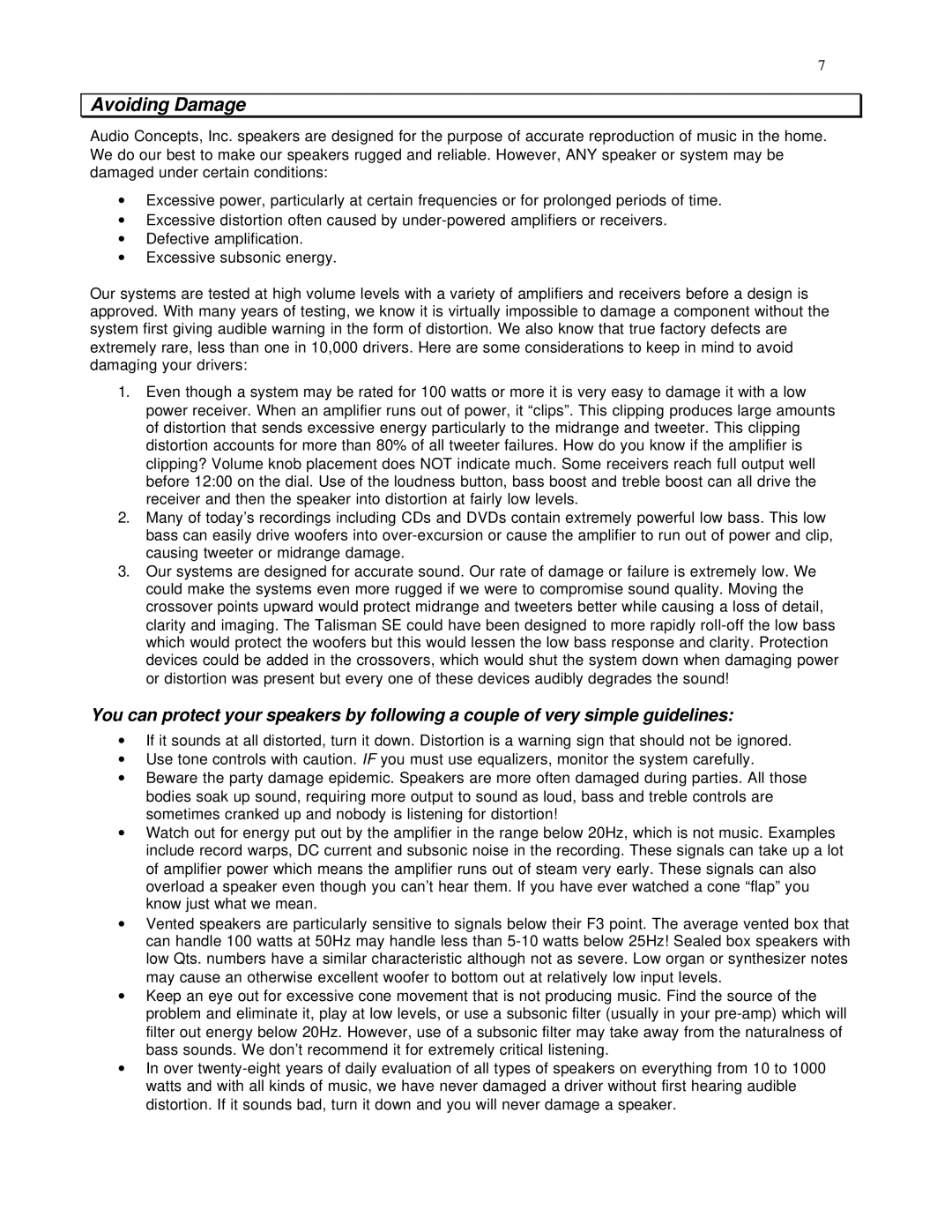7
Avoiding Damage
Audio Concepts, Inc. speakers are designed for the purpose of accurate reproduction of music in the home. We do our best to make our speakers rugged and reliable. However, ANY speaker or system may be damaged under certain conditions:
∙Excessive power, particularly at certain frequencies or for prolonged periods of time.
∙Excessive distortion often caused by
∙Defective amplification.
∙Excessive subsonic energy.
Our systems are tested at high volume levels with a variety of amplifiers and receivers before a design is approved. With many years of testing, we know it is virtually impossible to damage a component without the system first giving audible warning in the form of distortion. We also know that true factory defects are extremely rare, less than one in 10,000 drivers. Here are some considerations to keep in mind to avoid damaging your drivers:
1.Even though a system may be rated for 100 watts or more it is very easy to damage it with a low power receiver. When an amplifier runs out of power, it “clips”. This clipping produces large amounts of distortion that sends excessive energy particularly to the midrange and tweeter. This clipping distortion accounts for more than 80% of all tweeter failures. How do you know if the amplifier is clipping? Volume knob placement does NOT indicate much. Some receivers reach full output well before 12:00 on the dial. Use of the loudness button, bass boost and treble boost can all drive the receiver and then the speaker into distortion at fairly low levels.
2.Many of today’s recordings including CDs and DVDs contain extremely powerful low bass. This low bass can easily drive woofers into
3.Our systems are designed for accurate sound. Our rate of damage or failure is extremely low. We could make the systems even more rugged if we were to compromise sound quality. Moving the crossover points upward would protect midrange and tweeters better while causing a loss of detail, clarity and imaging. The Talisman SE could have been designed to more rapidly
You can protect your speakers by following a couple of very simple guidelines:
∙If it sounds at all distorted, turn it down. Distortion is a warning sign that should not be ignored.
∙Use tone controls with caution. IF you must use equalizers, monitor the system carefully.
∙Beware the party damage epidemic. Speakers are more often damaged during parties. All those bodies soak up sound, requiring more output to sound as loud, bass and treble controls are sometimes cranked up and nobody is listening for distortion!
∙Watch out for energy put out by the amplifier in the range below 20Hz, which is not music. Examples include record warps, DC current and subsonic noise in the recording. These signals can take up a lot of amplifier power which means the amplifier runs out of steam very early. These signals can also overload a speaker even though you can’t hear them. If you have ever watched a cone “flap” you know just what we mean.
∙Vented speakers are particularly sensitive to signals below their F3 point. The average vented box that can handle 100 watts at 50Hz may handle less than
∙Keep an eye out for excessive cone movement that is not producing music. Find the source of the problem and eliminate it, play at low levels, or use a subsonic filter (usually in your
∙In over
